Gen Con 2007 In A Nutshell 125
Another year, another Gen Con? Hardly. This year was the 40th anniversary of Gen Con, marked the announcement of the newest edition of Dungeons and Dragons, and was the first year videogame companies were actively sought out as exhibitors. Put together this resulted in what felt like record crowds, a healthy dealer's hall, and an instant conversation-starter with every other person at the event. Read on for notes on the new tabletop releases, thoughts on the new edition of D&D, impressions of the videogames that were in attendance, and a shameful admission of weakness.
Gen Con remains a bastion of tabletop gaming, but I'll admit it: I didn't get as strong a sense of the new tabletop game releases as I have in previous years. Instead, I spent time I would have normally put towards demoing games with dice and pieces towards getting a handle on the handful of videogames at the event. It seemed like almost every one was a Massively Multiplayer Online Game, but there were several representatives of other genres as well. What I did glean from this year's event is summed up very well by well-known designer Robin Laws: "This year was a holding pattern." Many of the companies making products for the Open Gaming License/d20 system seem to have died back. With the announcement of Fourth Edition, there will be a resurgence the year after next, but for this year things seemed to be fairly quiet.
This Year's Releases
So what was released this year? Biggest hits at the con, by far, were the Battlestar Galactica RPG, Changeling: The Lost, and the new version of Talisman. The Battlestar tabletop game is a sister product to the Serenity (as in Firefly) RPG, both of which use the same rules-set ("Cortex"), and are published by Margaret Weis Productions. The Serenity game has a fairly impressive following, with the core book already being on its fourth printing just a year after it was released. Battlestar seemed to be offering up a similar buzz. The Weis booth was also playing host to voice actor Jason Marsden, who plays the part of Tasslehoff Burrfoot in the upcoming animated Dragonlance movie. They showed off a trailer for the film, currently slated for release later this year.
White Wolf gamers may not have been waiting with baited breath for a new version of Changeling; it was never as popular as their 'big three' of Vampire, Werewolf, and Mage. Just the same, I saw a number of copies of the updated title walking away from the White Wolf/CCP booth this year. The attraction of EVE Online in the same booth didn't stop White Wolf players from picking up the latest in the 're-imagined' World of Darkness.
Talisman is probably a name familiar to long-time boardgame players. Under the Black Industries imprint, Games Workshop is re-releasing their classic adventure game with a slightly updated look and a few tweaks to the rules. From what I heard, though, it's almost entirely the same game that you knew back in the day. It just won't cost hundreds of dollars on eBay anymore. Lines for the title were going down the rows and out the door of the exhibit hall, and my impression is that they sold out pretty much every day they had new product to sell.
It didn't have as much buzz as other announcements at the con, but well worth noting was the formation of a company called Catalyst Game Labs. Catalyst is a new outfit formed from the ashes of "Fantasy Productions", or FanPro as it was more commonly called. FanPro has been publishing the Shadowrun RPG since FASA gave up the ghost a few years back, and while the quality of the books has been fairly high it would be kind to say that they've been released on any kind of regular schedule. The new company marks a turn for one of the most well-known intellectual properties in pen and paper gaming, with two new books (Emergence and Augmentation) available just at this convention. Working together with the folks behind the Classic Battletech line, they now having backing and a business plan. If you're a Shadowrun fan, there's going to be a lot to look forward to in the coming years.
Dungeons and Dragons Fourth Edition
The biggest news was, of course, the announcement that Wizards of the Coast is going to be releasing the fourth edition of Dungeons and Dragons next year. At a press event the day before their public announcement to Gen Con attendees, they tried to lay out the groundwork for their ambitious new plan. Essentially, these new books have been eight years in the making. The R&D team at WotC is looking to adapt Dungeons and Dragons to the way that it's played, and stop forcing gamers to play the game the way the game is set up. While the switchover from 2nd edition rules to 3.0 was an amazing step, it was in some ways still black magic. They now have a large base of knowledge to work from, that's going to let them change the game in fundamental ways. They hope it will be for the better.
The biggest changes will be mechanical. My review of the Saga Edition of the Star Wars RPG discussed the significant rules changes that title underwent; the R&D folks as much as admitted that book was sort of a 'test run' for concepts they'll be incorporating into fourth edition. The focus is going to be on ease of play for everyone, both in front of and behind the DM screen. Party roles will be more clearly defined. Encounters will be reformatted, and monsters retuned to more understandable roles and difficulty levels. It may just be hyperbole, but the designers are aiming to 'make D&D feel heroic again.' On the far end of the scale, this means that epic-level play will now be a core part of the game. That is, the Player Handbook will support level progression from 1-30. Levels 1-10 will be known as 'heroic' levels, where characters are better than the average human but still 'normal'. Levels 10-20 are 'paragon' levels, where characters accomplish feats only possible in a fictional environment. Levels 20-30 are 'epic' levels, where heroes will be able to step out into the world and change the course of history. Desiigner Chris Perkins put it this way: "We want first level to be more than 'run away, it's a kobold.' Gone are the days of the four hit point Wizard."
On top of that, WotC feels as though a new edition is necessary to support the other three columns of their ambitious new plan. Physical books are the most important part, but there are three other pieces that feed into the game. The first is community, exemplified by the terribly-named Gleemax.com website. Gleemax is going to offer up a single place where D&D gamers can come together to discuss the game, as well as CCGs, boardgames, and the lot; a MySpace for tabletop nerds, essentially.
Unfortunately, it's not clear how separate that piece will be from the ambitious D&DInsider.com. That site, essentially an outgrowth of the official Wizards of the Coast website content, is going to be a central hub for Dungeons and Dragons players. The late, lamented Dungeon and Dragon magazines will be available online there, and the site will also play host to the most novel concept in the fourth edition bag of tricks: The D&D Game Table. The Game Table is an online playspace, where groups can get together around a virtual table to actually play Dungeons and Dragons online. DMs will be able to lay out dungeon maps, place monsters, and run games. Players will have access to online versions of their purchased physical rulebooks, can make characters using a character creation tool, and can even create their own virtual miniatures for their characters. Voice chat will bring the whole group together. The WotC folks were very clear: this is not meant to take the place of your regular game. It's a place to go if your gaming group is spread across the country (or world) as so often happens in our busy modern world. They also envision a future where players who don't have regular games can hop online and connect with other folks to play in a regular campaign.
This last will likely be aided by the fourth leg of this concept: organized play. The RPGA has always been associated with but not a part of Dungeons and Dragons, if that makes any sense. With fourth edition the organized play campaigns will become a central component to the game experience. From your home, to the gaming store, online with the D&D Game Table, and all the way to conventions, the goal is for gamers to have a fun and slightly more formal handrail for gaming together. With a renewed interest in adventure publishing, designer goals seem to be to bring back the days when every D&D gamer could talk of playing through modules like Keep on the Borderlands or Tomb of Horrors.
All of this combines to an extremely ambitious goal: a brand new D&D. Just from anecdotal experience, from talking with players and retailers at the convention, my own gaming store, and from reading comments here on the site, the general reaction seems to be anger. The reason is understandable; 3.5 books aren't cheap, and many gamers have invested heavily in the current edition. In the latest D&D Podcast even the designers themselves admitted that 3.5 isn't 'that broken.' Thankfully, there's still quite some time before even the Player's Handbook comes out. The folks at Wizards have a good long while to explain to us what exactly they're planning to do. A long time to convince us, to reassure people that they really aren't ditching the OGL (full support), that their favorite campaigns will be supported (new Realms book next year, Eberron in 09), that it's worth shelling out another $90 for the upgrade. They've already begun, in fact; their ongoing design and development series has already put up posts on party roles, the new vision for Fighters, and what it's like to face a dragon in the new edition. If they even come close to delivering on what these articles imply, next year is going to be an interesting time to be a gamer.
Warhammer Online
Last year, I wrote this about WAR: "I wasn't very impressed, either with Mythic's showing or with the game itself. The buzz around the convention seemed to be that it is 'too much' of a World of Warcraft (WoW) ripoff." What a difference a year makes. Since then Mythic was purchased by EA, development has gone into high gear, and the company has done a tremendous job of getting out the word on what exactly Warhammer is all about. The result? A booth that was swarming with people from the moment the doors open until the exhibit hall closed. Their enthusiasm reflects my own; it's far and away the game I'm most looking forward to next year. I had the chance to take a Goblin Shaman for a spin in the Greenskins starting area, and the development team's cry of "War is everywhere" seems to have made for some inspired gaming.
Yes, it's primarily the same old level 1 experience you have in every other game. Kill grunts, gain xp, learn2play. But right away you start to see the difference. The Tome of Knowledge, for example, not only tracks what quests you're on, but tells you how many stunties you've killed (damn dwarves). Nearby a public quest is ongoing, as players struggle to kill the swarming squigs harrying a friendly giant. UI-wise, it looks like World of Warcraft redux, until you start to see all the extra doo-dads. My Goblin Shaman built up Waugh as he fought, which would have allowed me to heal more effectively had I been in a group. Morale rose as I fought too, allowing me to fire off special abilities just because I'd been fighting for a while. It's violent, it's fast, it's easy to pick up and play. And it's freaking hilarious. That dark British sense of humor seen in the tabletop game comes through loud and clear in-world, with everything from ability names (Brain Bursta, Geddup!) to quest themes. One of your very first encounters has you being tossed across a valley to the top of a dam, where you stuff unconscious dwarves into barrels and toss them over the side. I didn't even get a chance to check out Realm vs. Realm combat, the game's most exciting offering, and already I'm convinced of the title's potential. It's still in development, still getting the kinks worked out, but even in its half-finished state I think Warhammer is in a great position to turn heads next year.
Gods and Heroes
Perpetual's in-development Roman title, on the other hand, appears to be a bit adrift. At first blush it looks ready to succeed, with an inspiring and somewhat unconventional concept. The game focuses on combat in a mythical Roman setting where gods walk the land and monsters fill the wilderness. Combat with minion NPCs is the main mechanical draw. The minion system is a great addition to the genre, taking concepts seen in standard pet classes and the more advanced heroes of Guild Wars: Nightfall, and punching them up to the next level. On top of an interesting game setting and some new tweaks to gameplay, an ambitious animation system makes the game look as cinematic as it's described. Instead of blindly hacking at each other, fights involve stabbings, tosses, stamps, and throws. It's incredibly impressive when the animation system synchs up and pulls things off.
Unfortunately, there's a problem with that. Combat previously was 'locked', meaning that when two characters were fighting they were held fast so that animations could go off at set times. This looked really good, but playtesters found it too constraining. Perpetual listened, and has removed the locks. They're not working to tweak animation timing so that things will still look as cinematic as ever even without the lock system in place. It's still Beta, and there's time to get this stuff squared away ... but I have to be honest; the game felt like it was more than the two or three months away from launch than the company is claiming. When animations hit they look great, but right now combat is a mess to look at, moving through the world feels slow and cumbersome, and even the much-vaunted minion AI still needs to be tweaked. This game is doing a lot of things right, make no mistake, and I trust that when it launches it's going to garner some interest from players looking for something new. I just hope that the company gives Gods and Heroes the time it needs to succeed; right now it seems like it still needs a lot of work.
Fallen Earth
Big-name Massive games get a lot of press, but with the technologies behind MMOGs becoming ever better-understood smaller companies are starting to aim for a piece of that online pie. Fallen Earth is just such a game, backed by Icarus Studios. There's no word on a release date yet, but the little slice of the world I saw was fairly compelling. Assuming it goes live in the next six months or so, fans of the Fallout series will be able to sate their hunger on this post-apocalyptic treat. Fallen Earth imagines a southwest US ravaged by nuclear war and disease. In this bleak landscape you take on the role of an adventurer, working for the factions that control the vital resources of the area. Combat is a unique blend of FPS and RPG, with player skill determining if a shot hits and mechanics determining how much damage is done. The game feels like a fitting tribute to the complex CRPGs of yore. While it doesn't seem like it will reach widespread appeal, the players in this niche are going to have a lot to enjoy in this bleak, violent, and surprisingly funny Massive game.
Legends of Norrath
A collectible card game wrapped inside a Massively Multiplayer game sounds like crazy talk, but the folks at SOE are betting this will be a big hit. Certainly the concept is simple enough: give players of EverQuest and EverQuest 2 something to do while they're waiting for a group, or just as a way to mix things up a bit from the standard grind/kill/grind gameplay of a fantasy MMOG. While it's a simple idea, the execution is surprisingly robust. Players will be able to purchase virtual cards for a fairly low fee, or find them in booster packs dropped by in-world monsters. Decks can be constructed with the aid of a deck-building wizard (the software, not magical kind), and put to use combating players of both titles or NPC opponents. Gameplay seems to be of the 'easy to learn, hard to master' type that is quite prevalent in CCGs, with a few EverQuest-specific twists. The game will also offer up in-game loot from certain cards, just like a certain other CCG based on a MMOG ...
Pirates of the Burning Sea
I'll come clean: if the epic battle ever comes, I'll be siding with the buccaneers vs. the ninjas. It was a great pleasure, then, to get to have some more hands-on time with this most atypical online game. Although, again, I fear that broad market appeal may not be within reach, Pirates is shaping up to be darn fine game. The ship-to-ship combat is rock solid, immensely fun to play, and feels completely different from any other MMO experience you've ever had. There's a stateliness to the combat that makes the smoothly gliding schooners and soaring cannonballs somehow epic in scope. Swordplay is still a little rough, with the team still polishing in anticipation of a launch later this year. Even with the rough edges, this isn't your standard fantasy hack and slash. Players kick sand into the faces of their foes before a well-placed boot to the stomach takes them down. It's not fantasy, it's not sci-fi, it's piratical, and if you like Massively Multiplayer games you owe it to yourself to give Pirates of the Burning Sea a try.
Eye of Judgement
One of the few non-MMOGs at the event, this strange videogame/collectible card game/strategy game hybrid was drawing crowds simply because of its awesome visuals. The in-game art is definitely the first thing you notice, and is stunningly well-done. I was surprised by how much I enjoyed this game, which has players angling for control of a three-by-three grid. Cards are played onto each square of the grid, where they're analyzed by the new PlayStation Eye camera and animated on the television screen. While it initially comes off as just eye candy, a few minute's play reveals the numerous layers of depth to the game. Cards have facings, for example, and must be angled to ensure their blind spots are protected. Grid squares are aligned with different elements, as are creatures, requiring players to not only control the board but consider where their thralls are placed. It deserves commentary at length, but suffice it to say that it's not going to get the kind of success it deserves. Given the strange hoops required to jump through to play, this inspired title is just not going to find the audience it should. If you have a PS3, though, I highly recommend at least giving this a unique experience a try when it comes out later this year; they're even including the eye for no extra cost.
Conclusions
Last year I was lamenting the decision to include videogames in Gen Con's mission statement, worrying that this would be the end of the convention I've grown to love over the years. That was, of course, before seeing the lackluster showing of the E3 Media event and the closure of Gen Con So Cal. "Gen Con Indy" is now the only Gen Con, and is one of the furthest east offerings for gamers when it comes to videogames. In short: videogames coming to Gen Con may be the best thing to happen to it since the move to Indianapolis. Between the MMOGs, the D&D announcement, and a huge number of attendees, the convention felt revitalized. There was a hum and a murmer to the hallways that's been lower key in previous years. It was, as always, a chance to see game designers in their natural element, and all of the folks at WotC seemed to have an extra spring in their step this year.
The tabletop gamer is a dying breed; it's well acknowledge that Massively Multiplayer games are killing them off. Playing with your friends is so much easier in your home from a PC, and is something that can be done regardless of what time zone everyone is in. This year, though, I had hope that maybe we might not be dying off so quickly as I thought. Fourth edition is an obvious strike back, an attempt by Wizards of the Coast to fight 'the enemy' on its own terms while applying eight years of careful observation back into the game mechanics.
It's incredibly risky, and the future of the most popular and well-known tabletop game hangs in the balance as a result. On the one hand, this could blow the tabletop hobby firmly into the mainstream. Dice rollers could take their place at the side of the World of Warcraft players, proudly explaining their misunderstood hobby to their relatives in terms they can understand. Or, this could completely alienate the D&D playerbase and collapse the house that the d20 built. I personally am excited. I'm excited about the possibility of a Dungeons and Dragons game without the kruft. I'm excited about the chance to play online with friends across the country. I'm excited about organized play tied directly into the core game. And I'm excited about the future of a Gen Con with no imitators on the west coast, new attendees drawn by electronic gaming, and ever-more-professional game design companies working on the hobby I love.
I'm also, sadly, excited about the future of the World of Warcraft CCG. Perhaps because of my exposure to Legends of Norrath and Eye of Judgement, my demo of the now-year-old game left me vulnerable to the dealers in the exhibit hall. I've spent the last few days happily tweaking my Blue Shaman deck, and look foward to running it against all comers at PAX. Anyone have a Parvink or two they'd be willing to trade?
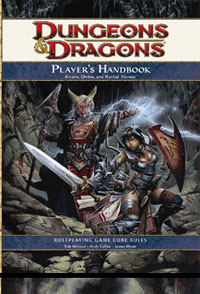
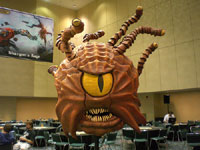
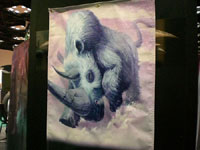
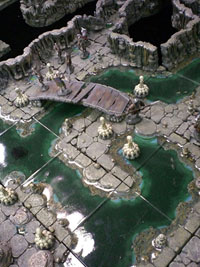
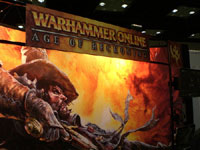

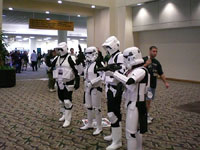
Ain't that old (Score:4, Funny)
Zonk must have failed his Spot and Listen checks all weekend.
Aw, to hell with all of this crap (Score:5, Funny)
Who cares about what games are being re-re-re-re-rewritten? Where are the pics of the girls in the skimpy anime outfits?
No, THIS is Gen Con 2007 in a nutshell... (Score:5, Funny)
Re:Aw, to hell with all of this crap (Score:3, Funny)
Re:Ain't that old (Score:3, Funny)
Not quite (Score:3, Funny)
Re:Watch out (Score:2, Funny)